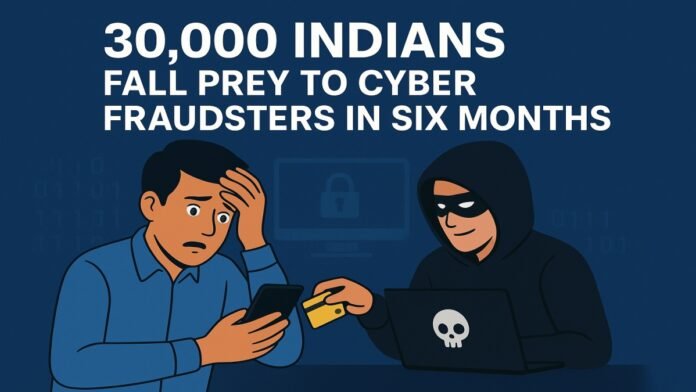
Key Points
- Over 30,000 people defrauded of approximately ₹1,500 crore through investment scams in past six months
- Bengaluru, Delhi-NCR, and Hyderabad account for 65% of all investment fraud cases
- People aged 30-60 represent 76% of victims; senior citizens (60+) comprise 8.62% of cases
- Average loss per victim stands at ₹51.38 lakh; Delhi reports highest per capita losses
- Bengaluru alone accounts for 26.38% of total financial losses nationwide
- Scammers exploit social media, WhatsApp groups, trading apps, and phishing emails to trap victims
- Home Ministry’s I4C warns against unverified investment platforms and suspicious digital offers
New Delhi: The Home Ministry’s Indian Cyber Crime Coordination Center (I4C) has released alarming data revealing that investment scams have reached epidemic proportions across India. In just six months, over 30,000 individuals have been defrauded of approximately ₹1,500 crore through sophisticated cyber fraud schemes that exploit digital payment systems and online investment platforms.
The report paints a disturbing picture of how cybercriminals are systematically targeting financially stable Indians through carefully crafted investment traps, using social media, fake trading apps, WhatsApp groups, and phishing emails to lure unsuspecting victims.
Three Metro Cities Bear Maximum Brunt of Investment Fraud
According to I4C data, 65% of all investment scam cases are concentrated in three major metropolitan areas: Bengaluru, Delhi-NCR, and Hyderabad. This geographic concentration reflects both the high digital adoption rates in these cities and the targeted approach cybercriminals employ.
Bengaluru Tops Fraud List: The Karnataka capital has emerged as the biggest victim of investment scams, accounting for 26.38% of total financial losses nationwide. The city’s reputation as India’s technology hub, combined with a large population of tech-savvy professionals with disposable income, has made it particularly attractive to scammers. The high concentration of startups, IT professionals, and entrepreneurs creates an environment where investment opportunities are frequently discussed, providing cover for fraudulent schemes.
Delhi-NCR Records Highest Per Capita Losses: While Bengaluru leads in overall fraud volume, Delhi-NCR has the dubious distinction of recording the highest average loss per victim. The national capital region’s wealthy demographic, combined with its role as a financial and business center, makes residents prime targets for high-value investment scams. Scammers specifically craft schemes that appeal to the region’s affluent professionals, entrepreneurs, and business owners.
Hyderabad Emerges as Third Major Target: The Telangana capital’s rapidly growing tech sector and expanding middle class have attracted cybercriminals. The city’s emergence as an alternative IT hub to Bengaluru has brought increased digital financial activity, creating opportunities for fraudsters to operate.
Prime Earning Age Group Most Vulnerable to Scams
The I4C report reveals that people between 30 and 60 years old represent 76% of investment scam victims, a finding that underscores how cybercriminals deliberately target individuals in their peak earning years. This demographic typically has accumulated savings, disposable income, and an active interest in wealth creation, making them ideal targets for investment fraud.
Several factors contribute to this age group’s vulnerability. Many are actively seeking investment opportunities to build a retirement corpus, fund children’s education, or achieve financial goals. They possess sufficient digital literacy to engage with online platforms but may lack the technical expertise to identify sophisticated scams. The pressure to maximize returns in a competitive economic environment makes them susceptible to promises of high returns with low risk.
Scammers tailor their pitches specifically for this demographic, using professional-looking websites, fake testimonials, and seemingly legitimate documentation to create trust. They exploit common financial aspirations early retirement, passive income, or beating inflation, to overcome natural skepticism.
Senior Citizens Lose Retirement Savings to Fraudsters
While younger demographics form the majority of victims, the report highlights a concerning trend: 8.62% of scam victims (approximately 2,829 individuals) are senior citizens above 60 years of age. This vulnerable population has suffered devastating losses, with many losing their entire retirement savings or fixed deposits built over decades of work.
Senior citizens face unique vulnerabilities that scammers exploit ruthlessly. Limited digital literacy makes it difficult to identify red flags in online investment schemes. Social isolation increases susceptibility to relationship-based scams where fraudsters build trust over weeks or months. The desire to secure a stable income in retirement makes them targets for schemes promising guaranteed high returns.
Many elderly victims report being approached through seemingly legitimate channels, phone calls from “bank officials,” emails from “government schemes,” or recommendations from “financial advisors.” The professional presentation and persistent follow-up create false confidence, leading to substantial financial losses that devastate their post-retirement security.
Staggering ₹51 Lakh Average Loss Per Victim
Perhaps the most shocking revelation from the I4C report is the average loss per victim: ₹51.38 lakh. This extraordinary figure indicates that investment scams are not small-scale operations but sophisticated schemes designed to extract maximum financial damage from each victim.
The high average loss reflects several factors. Scammers often employ “grooming” techniques, starting with small successful transactions to build trust before encouraging larger investments. They create urgency through limited-time offers or exclusive opportunities, pressuring victims to invest substantial amounts quickly. Many schemes involve progressive investment, where initial small gains convince victims to invest larger sums, eventually leading to total loss.
Delhi’s distinction of having the highest per capita losses suggests that scammers specifically target high-net-worth individuals in the capital region, tailoring schemes to extract maximum amounts from wealthy victims.
Digital Channels Become Primary Weapons for Fraudsters
Cybercriminals have mastered the art of exploiting digital communication channels to reach potential victims. The I4C report identifies several primary methods scammers use to perpetrate investment fraud:
Social Media Platforms: Facebook, Instagram, and LinkedIn are extensively used to promote fake investment opportunities. Scammers create professional-looking pages, run sponsored advertisements, and use influencer-style content to appear legitimate. They leverage social proof through fake testimonials and fabricated success stories.
WhatsApp Groups and Messages: Scammers add people to investment groups featuring fake success stories and manufactured urgency. They use WhatsApp’s encrypted nature to avoid detection and create false intimacy through direct messaging.
Fake Trading Apps: Sophisticated fraudsters develop mobile applications that mimic legitimate trading platforms. These apps display fake profits, allow initial small withdrawals to build trust, then lock accounts when victims invest larger amounts.
Phishing Emails: Professional-looking emails purporting to be from banks, financial institutions, or government agencies direct victims to fake investment platforms or request sensitive financial information.
Impersonation Tactics: Scammers pose as SEBI-registered advisors, bank officials, or successful investors to establish credibility and overcome skepticism.
Expert Recommendations for Protection
Cybersecurity experts and I4C officials emphasize several critical precautions to protect against investment scams:
Verify Before Investing: Always check if an investment platform or financial advisor is registered with SEBI, RBI, or other relevant regulatory authorities. Use official government websites to verify registrations rather than relying on information provided by the platform itself.
Beware of Unrealistic Returns: Any investment promising guaranteed high returns with zero risk is almost certainly fraudulent. Legitimate investments always carry some degree of risk proportional to potential returns.
Avoid Pressure Tactics: Scammers create artificial urgency to prevent victims from conducting due diligence. Legitimate investment opportunities allow time for research and consultation.
Use Official Channels Only: Invest only through government-recognized financial institutions, banks, and SEBI-registered brokers. Download apps only from official app stores and verify their authenticity.
Protect Personal Information: Never share OTPs, passwords, bank account details, or copies of identity documents through calls, messages, or emails, regardless of how official they appear.
Report Suspicious Activity: Use the national cybercrime helpline (1930) or visit cybercrime.gov.in to report suspected fraud immediately. Quick reporting can sometimes help recover funds through coordination with financial institutions.
The I4C emphasizes that awareness and vigilance remain the most effective defenses against investment fraud. As scammers continuously evolve their tactics, staying informed about current fraud trends and maintaining healthy skepticism toward unsolicited investment opportunities is essential for financial security.





















































